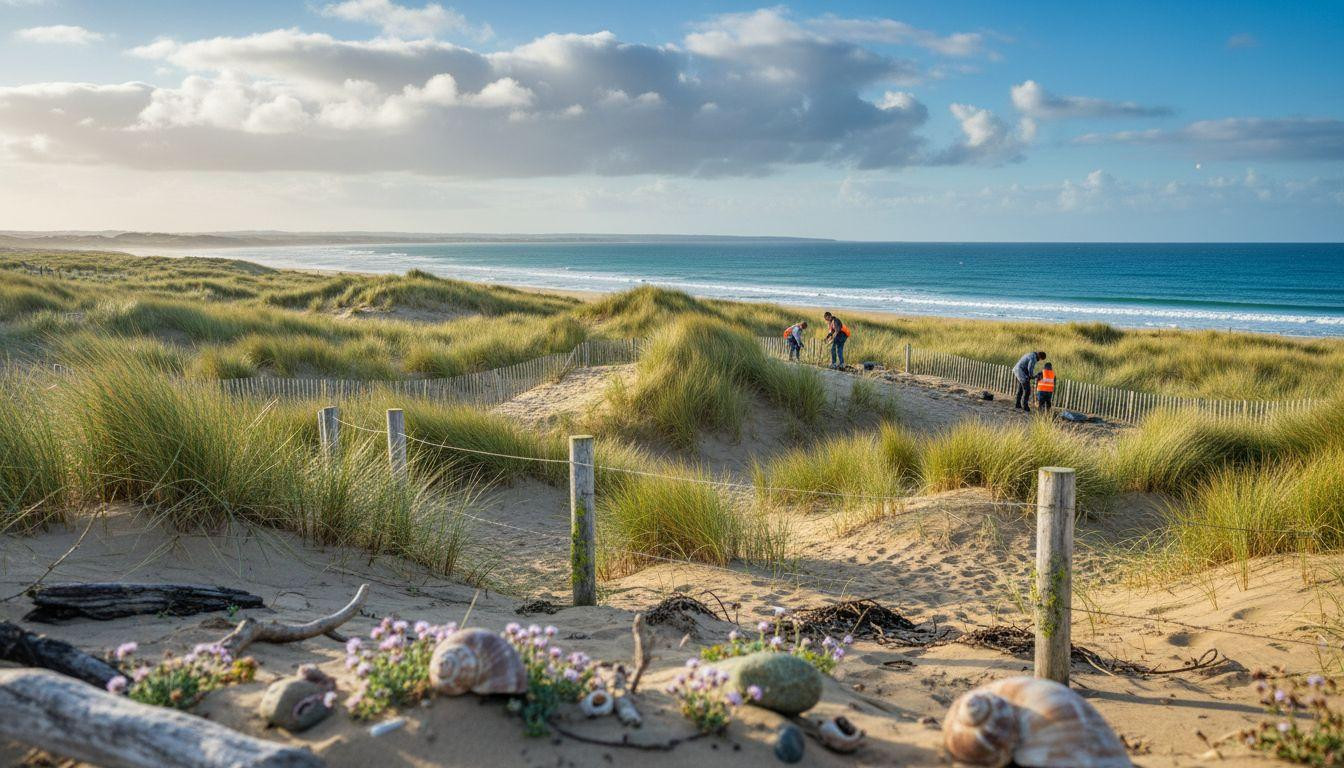While millions chase crowded beaches and commercialized coasts, a quiet revolution unfolds along 12 shorelines where communities have taken restoration into their own hands. These aren’t pristine wilderness areas preserved by governments or corporations. They’re working landscapes where residents roll up their sleeves, plant native grasses, and prove that grassroots action can heal decades of erosion and neglect.
From Irish dunes stabilized by volunteer labor to coral reefs restored by dive shop owners, these coastal communities demonstrate that the most powerful conservation tool isn’t regulation or funding. It’s neighbors who care enough to act.
Ireland’s Maharees Peninsula: where 500 residents restored golden dunes
The morning light catches marram grass swaying across the Maharees Peninsula, 85 miles southwest of Cork. What appears natural took years of community effort to achieve. Local residents spent weekends fencing fragile dunes and replanting native vegetation after decades of erosion threatened their 3-mile coastline.
The peninsula’s 500 residents organize monthly “Dune Days” where families gather to maintain the restoration work. Accommodations start at $90 per night, with guided ecology walks costing $25. The best time to witness active restoration is May-September when volunteer groups work the dunes at sunrise.
Visitors can stay at family-run guesthouses and join restoration activities through the local community center. The work continues year-round, but spring and summer offer the most opportunities for hands-on participation in this quiet corner of coastal Europe.
Birch Bay, Washington: 100,000 native plants stopping Pacific erosion
Two hours north of Seattle, Birch Bay’s 3-mile shoreline tells a story of community persistence. After years of erosion threatened waterfront homes, residents organized the largest volunteer coastal planting project in Washington state history.
The restoration achievement
Since 2022, volunteers have planted over 100,000 native coastal plants along eroding bluffs. The project earned the 2025 Best Restored Shore Award from the American Shore and Beach Preservation Association. Weekend planting sessions draw 50-75 volunteers who work alongside marine biologists.
How visitors participate
The restoration program welcomes volunteers every Saturday from April-October. No experience is required, and all tools are provided. Nearby accommodations range from $120-300 per night, with several bed and breakfasts offering volunteer packages that include breakfast and restoration gear.
Miami’s Brittany Bay Park: where mangroves meet urban innovation
Hidden within Miami Beach, Brittany Bay Park showcases how cities can integrate nature with development. The park’s boardwalks, built from recycled materials, wind through preserved mangrove forests that local residents fought to protect from development.
The conservation story
Neighborhood activists spent five years lobbying for the park’s creation in 2021. They convinced city planners to use recycled plastic lumber for all boardwalks and implement wildlife-safe lighting. The mangroves now shelter 47 bird species and provide storm surge protection for surrounding neighborhoods.
Supporting the effort
Free educational tours run daily at 9am and 3pm. The park’s visitor center sells locally made crafts, with proceeds funding ongoing maintenance. This urban oasis demonstrates that even densely populated coastal cities can prioritize conservation through community action.
Indian Island County Park, New York: sacred marshes protected by tribal partnership
On Long Island’s North Fork, tidal marshes stretch for miles around burial sites sacred to the Shinnecock Nation. The restoration here required delicate collaboration between tribal authorities, county officials, and local environmental groups to balance cultural preservation with ecosystem health.
The partnership has restored 120 acres of salt marsh over four years. Native plant species that hadn’t been seen for decades now thrive in the brackish waters. Guided nature walks respect both ecological and cultural significance, operating only with tribal-approved interpreters.
Visitor access is carefully managed through advance reservations. The $10 guided walks support both restoration work and tribal cultural programs. This model proves that conservation and cultural respect can strengthen each other.
Costa Rica’s Isla del Caño: where coral science meets dive community action
Twelve miles off Costa Rica’s Osa Peninsula, dive operators and marine biologists collaborate on cutting-edge coral restoration. The island’s protected waters serve as a living laboratory where community stewardship meets scientific innovation.
Local dive shops contribute boats and expertise to coral immunology research, testing new methods to help reefs survive warming oceans. Snorkeling tours ($65-85) include citizen science components where visitors help monitor reef health. The program has increased coral coverage by 23% over three years.
Access requires a boat trip from Drake Bay, with most visitors staying at eco-lodges that support the research. This remote location shows how even small island communities can lead global conservation innovation.
Your questions about community-led coastal restoration answered
Can visitors actually participate in restoration work?
Most programs welcome volunteers with advance notice. Birch Bay and Maharees Peninsula offer regular volunteer days requiring no experience. Equipment and training are typically provided. Physical requirements vary but most activities suit average fitness levels. Some locations like Isla del Caño require diving certification for underwater work.
How do these communities fund restoration projects?
Funding comes from diverse sources including tourism fees, volunteer donations, government grants, and local fundraising. Miami’s Brittany Bay Park uses craft sales and tour donations. Isla del Caño combines research grants with dive tour revenue. Most programs operate on modest budgets supplemented by volunteer labor.
Which locations work best for families with children?
Maharees Peninsula and Birch Bay offer the most family-friendly restoration activities. Both provide gentle beach environments perfect for children to learn about coastal ecology. Miami’s Brittany Bay Park features easy boardwalk access suitable for strollers. Community-based conservation often creates the safest and most educational experiences for young visitors.
The soft morning light reveals volunteer hands working in Maharees sand, carefully placing each native plant. Across an ocean, coral fragments grow stronger in Costa Rican waters tended by dive boat crews. These scenes repeat across a dozen coastlines where communities choose hope over helplessness, proving that the most powerful restoration tool is neighbors who refuse to give up on their shores.
